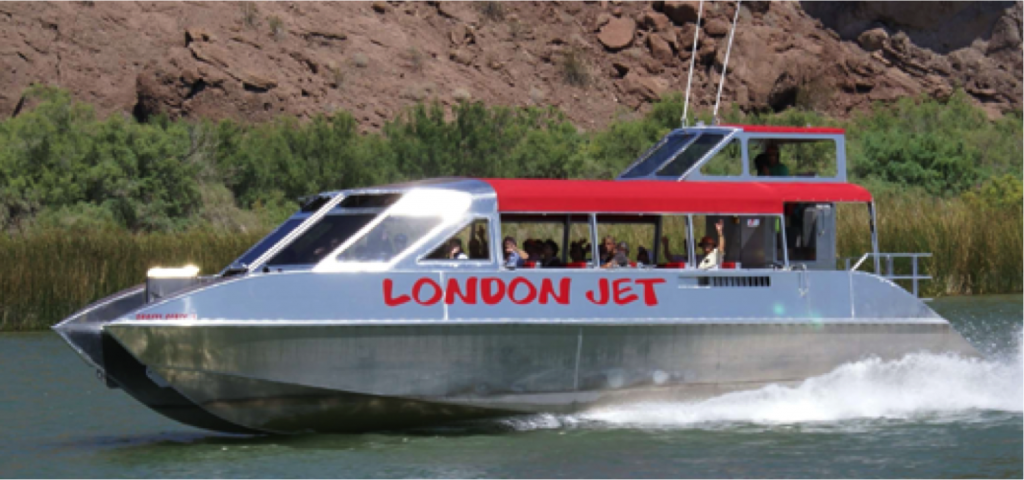
The photos show the London Jet Catamaran at full speed on the Colorado river and Lake Havasu for which a Hysucat hydrofoil system was designed by FASTcc in South Africa.
The standard Hysucat foil system consists of a mainfoil slightly forward of the Londitudinal Center of Gravity (LCG) and two smaller canter-lever trim foils on the tunnel side walls near the transom.
The complete stainless steel foil system was built by Hydrofoil Manufacturers S.A. and shipped over to Las Vegas for assembly.
The aluminium catamaran hull design is by Stephen F. Pollard of Specmar, Inc. (www.specmar.com) and the superstructure with detail design, arrangement and the complete building by Joe Fitch of London Bridge Jet Tours, Laughlin Nv., who also operates the London Jet as a sight-seeing touristic ferry on the Colorado river and lake at Las Vegas / USA, (google-link : London Bridge Jet Boat Tours; email ; londonjet@mac.com).
The London Jet can carry 42 persons if children are included or 34 adults at speeds over 40 knots (46.1 mph).
The London Jet has an overall length of Loa = 13.294[m](43.6�) including the swim platform, a maximum width of Bmax = 4.824 [m] (15.8�) and a tunnel width of Btunnel = 1.636 [m] (5.4�). The catamaran demi-hulls are fully asymmetrical.
Propulsion is by twin Scania D112 Diesel engines with 2 * 625 [kW] (2 * 850 HP) and Hamilton HJ 322 waterjets coupled without gearboxes.
Total weight fully laden is 15.410 [t metric] (33963 lbs).
Small interceptor blades are fitted to the transoms for trim regulation and as anti- porpoising devices.
The London Jet without the foil system had achieved 34.7 knots at 2175 rpm when fully loaded (Displacement weight 15.144 [t metric] ).
The trials of the foil assisted London Jet were conducted on the Colorado river in July 2012 during which small interceptors were fitted to the transom to reduce porpoising tendencies.
With the foil system installed and interceptor the fully laden top speed was 41.645 knots (48 mph) and with 32 passengers 43.38 knots (50 mph).
With 34 passengers the fuel consumption at 35 knots cruising speed is about 2 * 20 gallons per hour (75.7 litre fuel per hour).
Fuel consumption is approximate as the river velocities and depth�s vary constantly and this has an influence on the fuel consumption.
Pollard and Fitch are fully satisfied with the Performance of the London Jet and considering size and number of passengers it is one of the most efficient high speed ferries or water taxis around with increased top speed, reduced fuel consumption and pleasant sea-keeping.